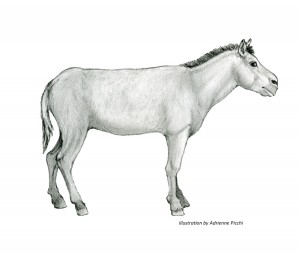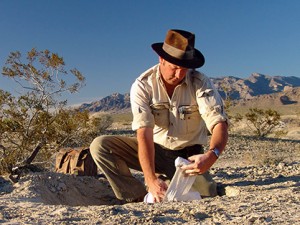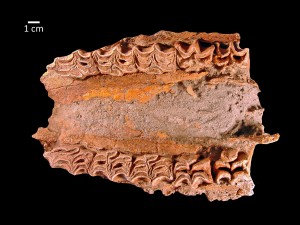Blast From the Past
By: Brittany Bevis
In 2013, scientists from the San Bernadino County Museum were excavating an Ice Age mammoth skeleton from Tule Springs, an area just north of Las Vegas, when they discovered something lying alongside the mammoth bones that gave them quite a shock. The mammoth’s neighbor was a horse, more specifically, an ancient Ice Age horse named Equus scotti, a species never before reported in this area of the US.
While horse lovers are familiar with the many different breeds of horses present today, Quarter Horse, Paint Horse, Appaloosa, Thoroughbred, ect., these horses belong to the same species, Equus ferus caballus, or the modern domesticated horse. However, did you know, that during the Ice Age, there were as many as four different species of horses?

This is what the Ice Age horse Equus scotti might have looked like. Image courtesy of San Bernadino County Museum.
To get a behind-the-scenes peek at what it’s like to uncover these dusty treasures of the past, that hint at the evolution of the horses we love today, we had the chance to chat with Eric Scott, Curator of Palentology at the San Bernadino County Museum.
Q & A with Eric Scott, Curator of Paleontology at the San Bernadino County Museum
Question 1: Is this an entirely new species of Ice Age horse that was discovered or had it just not been found before in this area?
Answer 1: “This is not a new species. The species, Equus scotti, was initially named in the year 1900, based on fossils from Rock Creek, Texas. But this species has never before been reported from Las Vegas or from southern Nevada.”
Question 2: Many people don’t know there were as many as four different species of Ice Age horses. Why were there so many species of horses back then, and we only have one today?
Answer 2: “This is a brilliant question! But the honest answer is that we have a lot more than one species of horse living today – at least in the loose sense of [the word] ‘horse.’ We have three different kinds of zebra, a few asses, and of course ‘true’ horses. The same appears to hold true for Ice Age North America, although scientists are still working out which of the fossil horses are more like zebras, which are more like asses, and which are more like ‘true’ horses.”
Question 3: Roughly how old would you say these fossils are?
Answer 3: “The horse fossils in question date to nearly 14 thousand years ago, in calendar years.”
Question 4: Were any clues discovered that would explain why the horse fossils were found with a mammoth skeleton?
Answer 4: “In our work in Las Vegas, we usually find single elements of extinct animals – a tooth here, a bone or bone fragment there. Sometimes, we find multiple bones or teeth. In a few of these cases, we even find multiple species – mammoths, horses, camels, bison, and so forth.”
Question 5: Why is this new find “forcing scientists to revise their understanding of horse evolution and extinction at the end of the Ice Ages?”
Answer 5: “To answer this, a bit of background: the large horse species, Equus scotti, is fairly common all over North America in the early and middle Pleistocene Epoch (the “Ice Ages”). We even have the species in southern California from rocks dating to this early period. But, by the later Ice Ages, we see a different large horse species in the American southwest; this horse, usually called Equus ‘occidentals,’ is best known from the Rancho La Brea “tar pits” in Los Angeles and from other late Ice Age sites like Diamond Valley Lake. We don’t yet know whether or not we’re seeing Equus scotti evolving into Equus ‘occidentalis’ in a restricted geographic region or else the immigration of the newer species northwards from Mexico and parts south. But, it’s a clear signal that something happened. And, it only appears to have happened in the southwest, to the north and east.”
Thanks to Eric Scott and the San Bernadino County Museum for this unique look at what it’s like to uncover horse fossils that date back 14,000 years!













